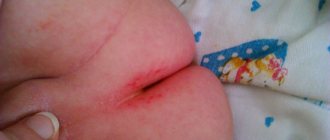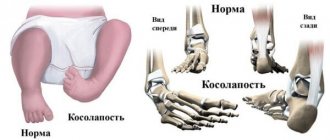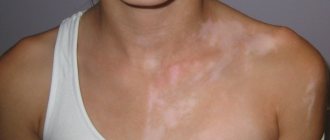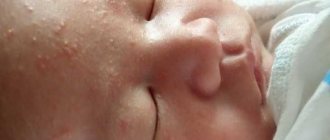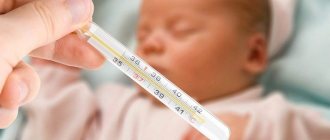Allergic reactions
Many of us have experienced this reaction. In most cases, it occurs with various rashes on the skin.
In mild cases it can be just red spots, and in severe cases it can be Quincke's edema, which in most cases is fatal.
The speed of development of the reaction is very individual and depends on the characteristics of the organism. It can be delayed, delayed or immediate.
There are three types of allergens.
- External allergens. These include various medications, food allergens (eggs, chocolate, fish, honey, red vegetables and fruits), various bacteria and microorganisms (dust mites, pollen and flowers of various plants and trees) in general, everything that gets into our organism.
- The second reason is our own antigens. In this case, the body mistakes its own cells for foreign ones and actively damages them.
- The third reason is transplants. Often the body, for example, during a bone marrow transplant, it often does not take root, and the body rejects it.
Patients often complain of burning and itching, red spots, various rashes, swelling and cracking of the skin.
Sometimes taking antihistamines is not enough. Only a doctor should treat an allergic reaction. Do not forget that the main complication of allergies is anaphylactic shock, which can be instantly fatal.
To treat the allergic process, sorbents are necessarily used. This can be an intravenous administration of a solution of Reosorbilact , or an intravenous administration of White Coal Atoxil and Enterosgel are also taken .
Alternating antihistamines has also worked well: for example, Suprastin , Tavegil . Convenient medications for allergies: Claritin, Loratodin, Eden . Sodium thiosulfate and Dexamethasone is also used .
Bacterial infections
Exposure to bacterial factors leads to the development of growths on the surface of the skin in the abdominal area:
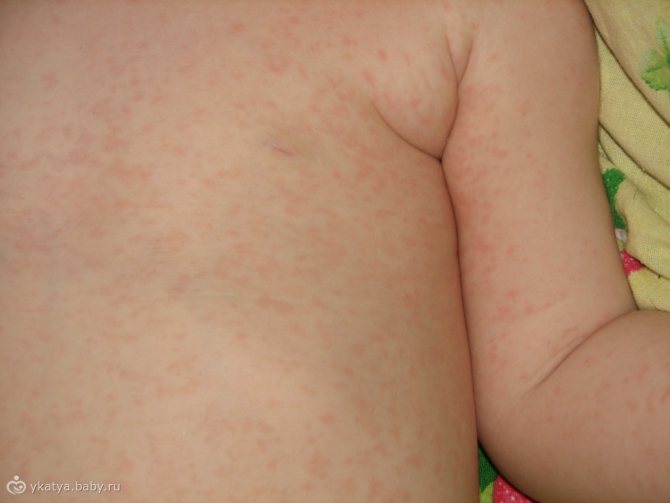
A disease that affects the skin with staphylococci is called pyoderma. The patient suffers from a purulent rash, and treatment occurs with ointments and antibiotics.- Scarlet fever causes inflammation of the tonsils and the development of rashes throughout the baby's body, in particular on the tummy. Among the distinctive features of this disease is a crimson tongue. A specialist can choose a suitable treatment plan.
- Erysipelas is a series of skin changes that appear in the most unpredictable places. In 20% of cases, the problem is localized in the abdomen. In this case, the formations acquire a reddish tint, and their edges become uneven. An increase in body temperature cannot be ruled out. Highly effective drugs and ointments are used for treatment .
- Typhoid or typhus. It poses a real threat to the life and health of the child. The symptoms are so obvious that they cannot be confused with others. We are talking about bloating, constipation, fever and rash. Treatment must be inpatient. Today the disease is completely curable.
Poor nutrition
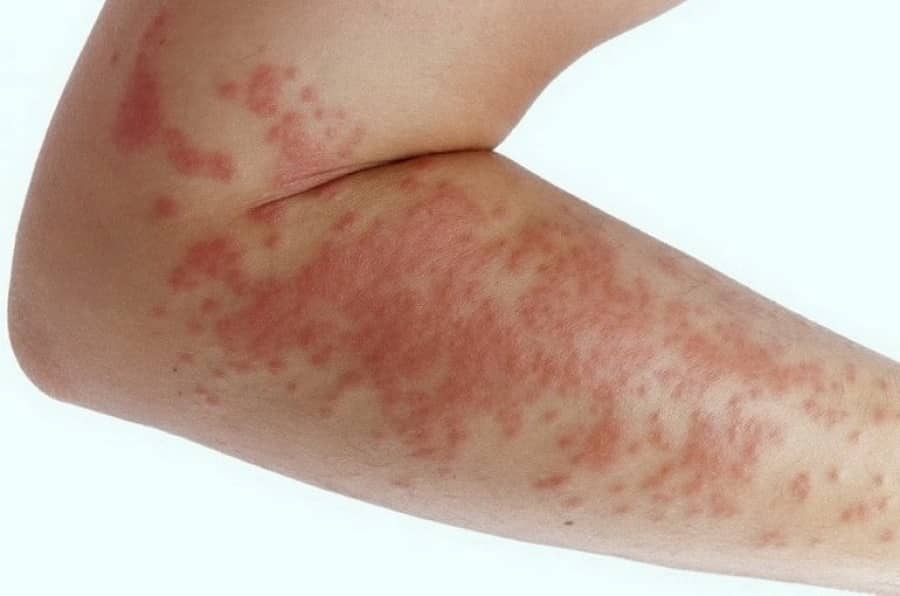
Red spots can be caused by poor diet. Excessive addiction to smoked, fried, sweet, salty, spicy foods can provoke their appearance. To reduce symptoms, it is necessary to exclude “suspicious foods” from the diet.
Having excluded suspicious products, you need to observe the stains for several days. If the rashes have decreased, then the culprit was poor nutrition and the main treatment is minimal consumption of these products.
Types of rashes in children (photos and descriptions)
A rash is a local change in the normal condition of the skin. In order to make a correct diagnosis, you need to be able to understand its various types and their affiliation with certain diseases.
The rash may look like:
- spots;
- pimples;
- tubercles;
- bubbles;
- ulcers.
If you look closely at photographs of various rashes, you will see that each individual disease is characterized by a certain type of rash. For example, with dermatitis, this is redness of the skin, its swelling and at the same time severe itching, which is the main sign of the disease.
If bubbles filled with clear liquid appear on the baby’s body, there are many of them throughout the body and there is an increase in temperature, it may be chickenpox.
If the temperature is normal, the bubbles are concentrated in one place and there are few of them, most likely it is contact dermatitis. So, a rash without fever and with a normal general condition of the body (the baby is cheerful and active), this is not an infection, but an allergy.
Bubbles with purulent contents appear when a bacterial infection is added to the underlying disease. This happens due to frequent scratching of itchy areas. Therefore, you need to try to alleviate the manifestations of itching in the child and not allow him to injure the skin, so as not to worsen the situation with a new disease.
Video from Dr. Komarovsky:
Allergy
We are surrounded by many allergens, although not everyone suffers from this disease, but every year the number of patients is rapidly increasing.
Very often, parents notice that after eating certain foods (chocolate, sweets, tangerines and others), their child’s skin begins to turn red, become covered with spots, rashes, stomach pain, and digestion upset.
An allergic rash on the body is usually pinkish-red, raised and uneven. In some cases, it is absent, but skin redness, irritation, and swelling are observed. Itching is always present.
Photos of allergic rashes in children:
Children can develop food allergies in the first months after birth. This happens if the mother does not follow healthy eating principles, smokes, takes medications, or lives in an environmentally unfavorable area.
For the baby, the female body becomes a conductor of toxic substances from the environment, which serve as allergens.
In many cases, a child outgrows a food allergy by the age of 3-5, but very often it becomes a “starting” platform for the development of other forms of this disease. As a rule, it is followed by household allergies in the form of respiratory diseases (colds).
After visiting the circus, zoo, or library, the child develops an obsessive cough, runny nose, and breathing becomes wheezing, but the body temperature is absolutely normal, which allows one to exclude acute respiratory infections. Later, already at school age, pollen allergies follow.
Prickly heat
Skin lesions that develop mainly in infants due to severe overheating. The disease is the result of sweat retention in the excretory ducts of the sweat glands.
Many small blisters filled with liquid content appear on the skin of the trunk and the inner surface of the limbs. When they dry out, a slight peeling remains in their place.
In areas of large folds, areas of redness (sometimes weeping) may appear, along the edges of which blisters are found (miliaria rubra). They may be accompanied by itching.
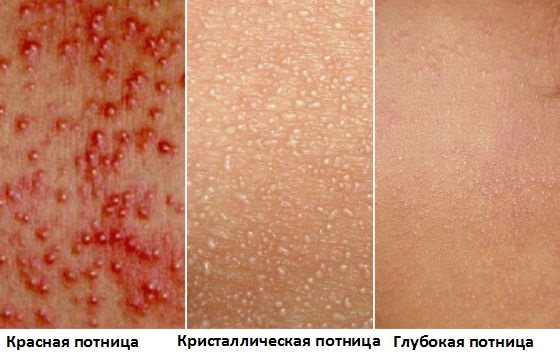
Chicken pox
A viral disease that affects children mainly from 6 months to 7 years. In adults it is much less common. The pathogen is a member of the herpes virus group and is transmitted primarily by air.
First, small bubbles with transparent contents appear on the body, and then on the face, head, and limbs. At the same time, the temperature rises, but, as a rule, not higher than 38 degrees.
The bubbles, the size of a match head, gradually enlarge, reaching the size of a grain of rice, then gradually dry out and form a crust, which falls off after ten days. After the first wave of rashes, another appears, and then another.
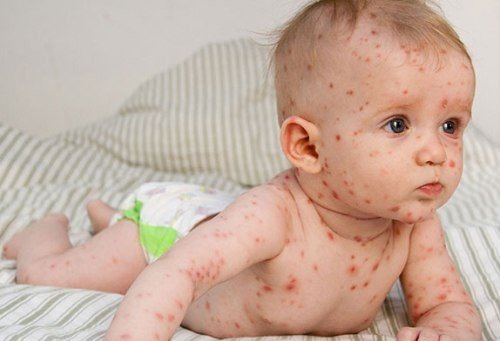
As a result, fresh rashes are visible on the body along with traces of old spots and wounds from scratching. Usually this process does not drag on for more than a week. The cyclicity of the development of rash elements is a characteristic feature by which, as a rule, the disease is recognized.
Chickenpox itself is not a dangerous disease, but it can have complications such as pneumonia, meningoencephalitis, and viral damage to internal organs. The symptoms are unclear, as one disease overlaps with another. Sometimes it is very difficult to recognize the addition of a secondary infection.

Development of a rash with chickenpox
There are often cases when this ends in death, since assistance in the form of antibacterial therapy was not provided in time. Adults or children over eight to ten years of age are most susceptible to complications after chickenpox.
The virus can manifest itself as another disease on the body. If a child is 2 years old or older, blisters with liquid contents may appear on his lip - this is also a herpetic infection. As a rule, such rashes accompany colds. At an earlier age they rarely appear.
Video from Dr. Komarovsky:
Rubella
An infectious disease characterized by small-spotted rashes, swollen lymph nodes, and minor catarrhal symptoms in the respiratory tract. The baby’s general condition does not suffer particularly; often the temperature does not rise at all (or no higher than 38 degrees). Lethargy and malaise are observed, older children may complain of headache, cough and runny nose are minor.
The maculopapular rash first appears on the face, and after a few hours spots appear on the abdomen and throughout the body. The elements are round in shape and their size is approximately the same.
The rash is mild in nature, sometimes patients have only a few pale pink spots. After a few days, they disappear without a trace, leaving behind no peeling or pigmentation.
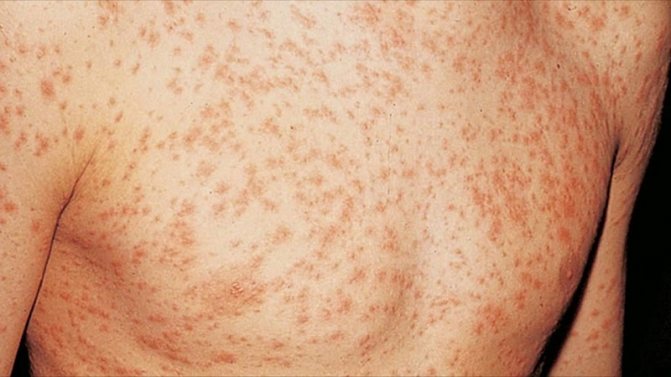
Measles
An infectious, highly contagious disease, along with symptoms of intoxication, is characterized by catarrhal inflammation of the mucous membranes of the respiratory tract and a cyclic rash of maculopapular rashes all over the body. The causative agent, a filterable virus, is carried over considerable distances by air.
Measles occurs primarily in early childhood (7 months - 14 years), after which lifelong immunity remains. In adults, this disease occurs as a rare exception, usually in those who did not get sick as a child. Newborns do not get sick thanks to the specific immunity transmitted through the placenta by the mother.
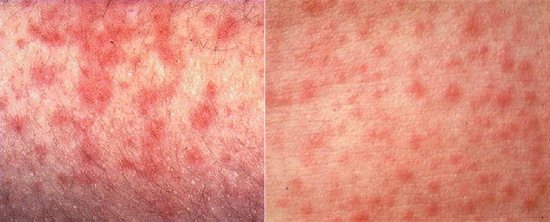
Measles rash
Insect bites
Most insect bites are quite harmless and do not pose a threat to children. Danger arises if the bite occurs on the mucous membrane of the mouth, face, or neck.
In this case, very severe swelling occurs, which can block the airway. It is necessary to give the child a piece of ice to suck on until the doctor arrives.
After stings from bees, wasps, and hornets, local allergic reactions usually occur. But it is possible that the process can affect the entire body (swelling, redness throughout the body, pain, itching), and in some cases cause anaphylactic shock. You should immediately try to remove the sting with your fingers or tweezers.
Persons with hypersensitivity to the poisons of such insects should avoid places where they may encounter them, and also take appropriate medications with them on a country holiday. Most deaths occur within the first hour after the sting.
Other diseases
In addition to the above-mentioned cases, there are a number of pathologies in which the rash is a constant symptom. For example, serum sickness. It occurs as an immunopathological response of the body to the administration of medications subcutaneously.
A rash in the form of hives begins from the place where the injection was given. Everything is accompanied by itching, and the lymph nodes become enlarged.
Atopic dermatitis develops as a result of the body's genetic predisposition to a hypersensitive reaction to any substance. The disease can be caused not only by contact allergens, but also by those that enter the body through the respiratory or food route. A rash appears in the form of small nodules and unbearable itching.
Video from Dr. Komarovsky:
Infectious diseases
Red spots on the body sometimes appear as a result of infectious diseases.
The most common culprit is scarlet fever. This is an acute infectious process that occurs with fever, sore throat, weakness and intoxication.
This disease used to be called purple fever. This is due to the fact that small pinpoint rashes appear on the body (see photo above). The source is a sick person.
Infection occurs through close and prolonged contact with a sick person, through dirty hands and household items.
Rubella
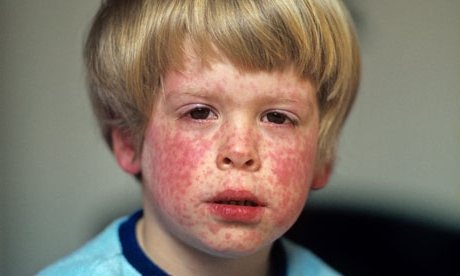
Rubella or 3rd disease - it also causes rashes to appear on the body. This is a viral disease that causes a rash to appear on the inside of the limbs around the joints.
Patients complain of a slight increase in temperature, sore throat, and swollen lymph nodes. The disease is especially dangerous for pregnant women, as it causes mutation in the fetus.
The route of transmission and the mechanism of infection are the same as for scarlet fever.
Chicken pox
Chickenpox in adults is caused by the herpes simplex virus. With it, a rash appears on the skin, which then turns into a dark pink spot of irregular shape and rising above the skin.
Infection occurs through contact with a child with chickenpox.
During treatment, do not use aspirin to combat fever under any circumstances. Taking it may cause the development of hepatic encephalopathy.
Measles

Measles is an acute infectious disease that can cause epidemics. Patients complain of high fever and red spots.
Children most often suffer from this disease. Adults suffer the disease the worst, as the disease progresses with an increase in temperature up to forty degrees.
The rash persists for about ten days, and patients experience severe itching. After the rash disappears, pigmentation remains.
All of the above infectious diseases do not require specific treatment.
Usually the doctor prescribes antipyretic drugs such as Ibuprofen or Paracetamol . Antihistamines are used to reduce itching.
It is important not to forget about vitamins. The complex must include vitamins A and C. The rash is treated with brilliant green.
Types of rashes, for what reasons they appear
There are dozens of diseases in which the rash always appears, and hundreds more in which it can appear. Only a small part of these diseases are dangerous; if the rash is not accompanied by other symptoms and is not spread over a large area of the body, then it is not dangerous.
All rashes are divided into two groups:
- Primary - appear on healthy skin as a result of a pathological process
- Secondary - appear against the background of primary
Let's take a closer look at the primary rashes that occur most often.
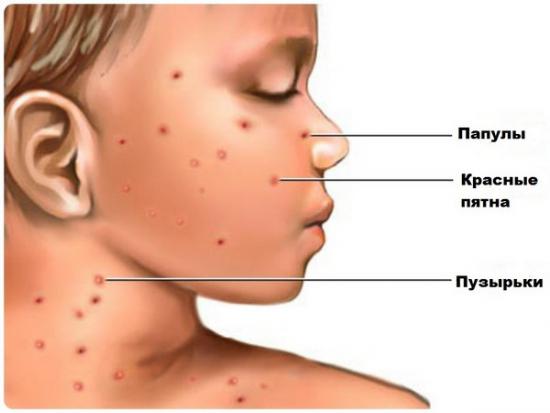
Based on their shape, size, nature of contents, and contours, they can be classified into the following types:
- A tubercle is an element without a cavity, a hard lump that lies deep in the skin.
- A blister is a dense, raised area of skin, pink, and lasts a short time. Occurs from nettle burns and insect bites
- A papule, or nodule, is a cavity-free element with discolored skin, rising above the rest of the skin, resolving without a trace.
- A bubble is an element that has a bottom, a tire and a cavity, up to 0.5 cm in diameter, with liquid contents.
- A blister is a bubble larger than 0.5 cm in diameter
- An abscess is an element with purulent contents.
- Spot - change in skin color
- Roseola is a small pinkish or red spot up to 5 mm in size, does not protrude above the skin level, disappears with pressure
The skin is the largest human organ by area; skin diseases are called dermatoses. The rash can be the result of one or more diseases. The causes of the rash are divided into several groups, depending on the nature of the disease
A small rash on a child’s face may be a consequence of:
- allergies
- infectious diseases
- vascular and blood diseases and other non-communicable diseases
- improper skin care
Venereal disease (syphilis)

Sometimes red spots appear with syphilis. They resemble pale pink stars and appear during secondary syphilis. Patients feel unwell, the temperature rises, the lymph nodes become inflamed, and extensive growths appear on the genitals.
Chickenpox in a child
Chickenpox is an infectious disease that is transmitted by contact from one person to another. after infection with the virus (the infection is a herpes type and is the causative agent of smallpox), a rash appears. It resembles blisters filled with fluid, they can itch and itch. The temperature may increase slightly (often this does not happen). After a couple of days, the bubbles open and form crusts.
In this case, no special treatment is needed. All you need to do is treat the infected areas with a solution of brilliant green 12-16 times daily . This will help get rid of the infection. It must be said that a person who has had chickenpox develops lifelong immunity, that is, it is almost impossible to get sick again.
Dermatological skin diseases
Ringworm
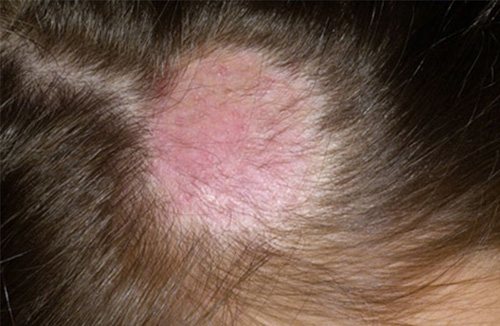
Ringworm in humans is a generalized concept of dermatoses, the main symptoms of which are red spots on the human body (see photo above).
There are several types of lichen:
- Ringworm - eczema
- Shingles (viral infection)
- Pityriasis versicolor (fungal infection)
- Pityriasis rosea - pityriasis (probably a viral infection)
- Ringworm - trichophytosis, microsporia (fungal infection)
- Lichen squamosus - psoriasis
- Lichen planus (Wilson's lichen, lichen planus) - dermatosis of unknown etiology
The disease is of an infectious-allergic nature, except for shingles. It is caused by the chickenpox virus.
When treating red spots, it is necessary to take into account the reasons that stimulated the occurrence of pathology. Vitamin therapy, antibiotics, antihistamines and sedatives have a positive effect.
Psoriasis
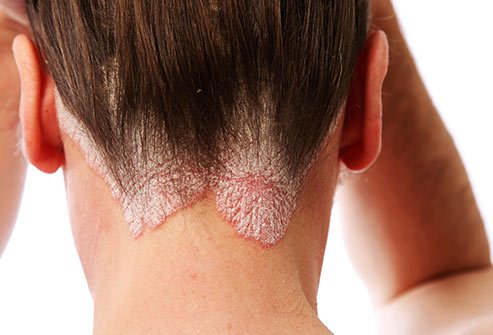
Psoriasis (scaly lichen) is a chronic dermatosis. The main symptom is scaly red spots that are covered with silvery-white scales.
At the first stage, the red spots are free from peeling, but even with minor skin trauma, it begins to actively progress. A characteristic feature of the rash is its prevalence and symmetry.
More than twenty different methods and schemes have been developed for treatment, which produce a positive effect, but do not allow complete healing and disappearance of red spots.
In most cases, therapy is relieving. In the fight to progress the fight against the disease, the following have proven themselves well:
- vitamins of group B, E, A;
- detoxification drugs ( Sodium thiosulfate and Calcium gluconate ).
Eczema
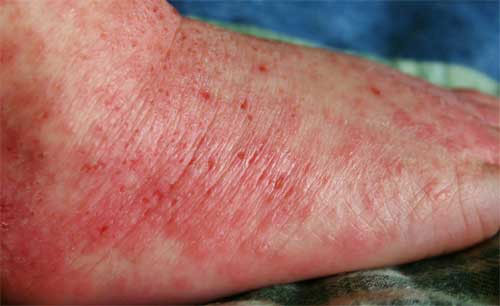
Red spots sometimes appear with eczema (tinea versicolor). The reasons for its appearance are not fully understood. But doctors were able to prove that pathological processes in the nervous and endocrine systems have a huge impact on the appearance of red spots.
There is a violation of sweating, thermoregulation, and vascular reactions.
Allergens sensitize the skin and cause an eczematous process. At the first stage the following appear:
- redness;
- severe itching;
- temperature increase.
Treatment of eczema requires a careful approach. It is necessary to get away from the influence of irritating factors, such as:
- chemical substances;
- exposure to sunlight;
- dampness, dust;
- skin parasites.
The diet should be complete and rich in vitamins. Local treatment is prescribed as part of complex therapy. At the same time, desensitization of the body is carried out with autohemotherapy.
Atopic eczema
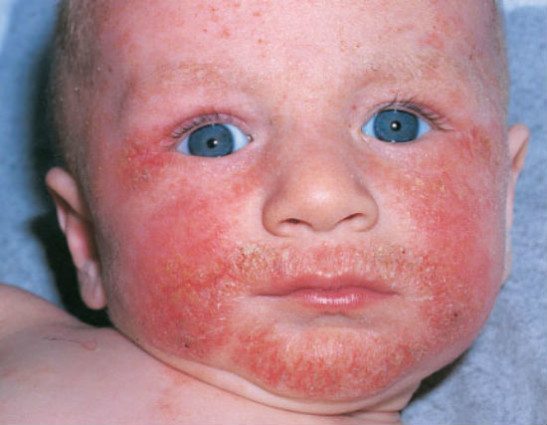
Atopic dermatitis or atopic eczema - with this disease, red spots can appear both in early childhood and throughout life.
The pathology is hereditary in nature, not contagious to others, but after treatment in patients it gives frequent relapses.
Rash due to improper care
If the temperature regime and the rules of daily hygiene are not observed, the child may experience the following problems:
- prickly heat
- diaper rash or diaper rash
All small children will develop some kind of rash.
Prickly heat
Heat rash is an especially common problem - skin irritation due to overheating. In young children, the sweat glands are not yet fully developed, which leads to delayed sweating. The rash with prickly heat is small, often pimples with liquid, located in clusters, the skin in the area of the rash is red, but if the irritation is not severe, the skin may remain its normal color.
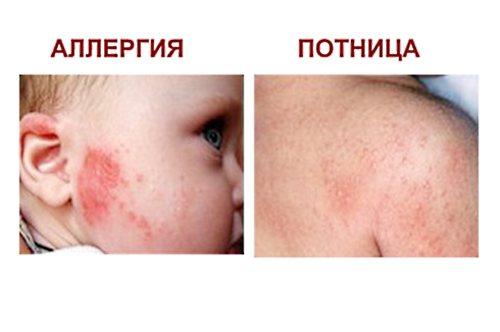
Miliaria can appear on the face if the child sweats under a hat or while sleeping for a long time without changing the position of the head. Most often, prickly heat is located in skin folds.
Diaper dermatitis
This is an inflammation of an area of skin due to exposure to unfavorable factors; the skin is bright red and painful; in young children, diaper rash most often occurs on the buttocks and groin. Exposure to friction, overheating, and prolonged contact with urine and feces lead to damage to the delicate skin of babies, which in turn leads to dermatitis.
In newborns, some types of rash are considered common.
Hormonal rash
It is most often located on the face and scalp in the form of small reddish pimples with a yellowish or white dot in the center, disappearing in one place, they appear in another, not dangerous, goes away by three months or earlier.
Erythema toxicum of the newborn
The rash appears in the first days of life in the form of red spots of various sizes; gray-yellow tubercles appear in the center of the spots, most often located around the joints of the arms and legs. It is not dangerous and usually goes away in 1-2 weeks.
The appearance of a rash on a child’s face does not always indicate a dangerous disease. When parents understand why this rash appeared, they become calmer.
If a month old baby has a small rash on his face, what measures should parents take?
- Determine the nature of the rash - severe or not, with or without itching, whether the child is worried or not.
- Check the temperature and assess the general condition of the child - if everything is normal, then you can observe the rash for a while
- If the rash is caused by improper care, then eliminate all adverse effects.
- If the child’s general condition is impaired and the rash is accompanied by fever, call a doctor immediately.
Treatment of prickly heat and diaper dermatitis boils down to the fact that the child must be bathed every day, the water temperature should be 34-36 degrees. You can add a decoction of string or chamomile to the water, but this is not necessary. When bathing, use soap once a week, this is enough. Leave the child without clothes more often, use high-quality soft diapers, and change them in a timely manner. Apply talc, powder or cream to the rash if the skin dries out. The most important thing is not to overheat the child, the room temperature should be between 20-22 degrees, this is what all pediatricians advise.
Vegetovascular dystonia (VSD)
Vegetative-vascular dystonia is a collective concept that is based on an imbalance of biochemical processes and disharmony of internal physical cycles. Patients suffering from this disease complain of:
- fatigue;
- psychological discomfort;
- disturbances in the functioning of the heart;
- the appearance of red spots;
- changes in blood pressure;
- dizziness;
- headache.
Red spots appear after a person has become nervous. Women are most often affected; a characteristic feature of the rash is that it does not go away for a long time.
The treatment is complex. One method does not remove red spots on the human body.
Be sure to use general health measures, reflexology and psychotherapy. Psychoregulation is the most effective method of dealing with the problem.
Associated symptoms
Along with a rash on the stomach and back, a number of other phenomena may occur. Let's list the most common ones:
- The rash on the body may become wet and blisters appear.
- The skin in the infected areas began to peel off and became dry.
- The rash covers not only the stomach, but also other parts of the body: legs, arms, chest, face, back.
- Sometimes, with some rashes, increased lacrimation and photophobia are noted.
- Pustules appear in some areas.
- Sometimes general weakness appears and the child’s condition worsens.
- With some rashes accompanied by some disease, the body temperature may rise.
- Chills and fever are possible.
- Sometimes problems in the functioning of the digestive tract may appear: diarrhea, vomiting and nausea.
Nervous system
The state of the nervous system plays a huge role. Many diseases develop due to nervousness:
- lupus;
- diabetes;
- heart and vascular disease;
- gastrointestinal disorder
The list is huge. Even before the disease itself appears, the patient develops red spots on the skin. There can be many reasons for the appearance of red spots.
In most cases, this is a genetic predisposition that is inherited, or if the individual is easily vulnerable, lethargic, constrained, angry, irritable - such manifestations of character lead to stimulation of the nervous system. And as a result, spots on the body.
Treatment is individual, but usually the therapeutic complex includes antihistamines and immunomodulatory agents.
Mandatory use of moisturizing creams and anti-inflammatory tinctures. The use of phototherapy gives good results.
You need to be as nervous as possible and rest as often as possible. Try to avoid stress, eat right, strengthen your immune system. Relaxation on the sea coast is shown. If you have red spots, do not wait for more serious symptoms; consult a doctor so as not to miss a serious illness.
Blood and vascular diseases and other non-communicable diseases
Diseases that lead to impaired vascular function may be accompanied by small ruptures of skin vessels, and the rash has the appearance of hemorrhages. If there is a red rash on the bridge of the nose on the face, spreading to the cheeks, this is a sign of systemic lupus erythematosus. This is an autoimmune disease; immune cells perceive their own connective cells as antigens and begin to fight them.
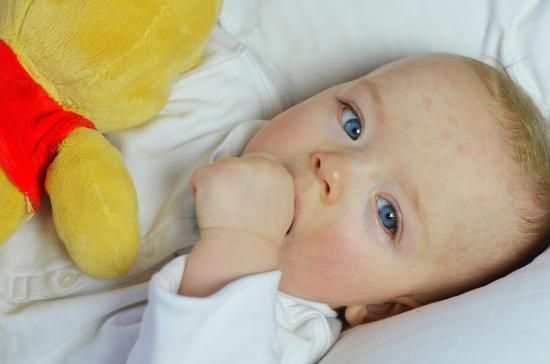
Leukemia and various tumors can provoke skin changes. However, in these cases, skin manifestations will only be a secondary problem. Diagnosis of such diseases is not carried out only by the condition of the skin.
Diabetes mellitus leads to pathological changes in organs and tissues, including the skin. On the face, this can manifest itself in the form of redness of the cheekbones and chin due to vasodilation, such a change is called diabetic rubeosis.
Red, dry, raised papules above the surface of the skin, merging with each other, are a sign of psoriasis. Psoriasis is diagnosed in 2-4% of the population, every third patient indicates the first symptoms before the age of 20. The nature of the disease is not clear; it is assumed that it is based on a dysfunction of the immune system.
Rash Treatment Options
To determine the treatment method, it is necessary to establish the cause that caused the rash in the child. To do this you will need:
- Observe whether the baby has symptoms of infection (cough, runny nose, fever).
- Remember whether the infant or older toddler has had contact with sick people (for example, whether other children in the kindergarten the child attends are sick with rubella, chickenpox and other diseases).
- Check to see if the baby has inflammation of the eyes (if there is one in combination with rashes, rubella or measles can be suspected).
- See if new elements of the rash appear and how quickly they go away.
- Remember what the child ate in the next few days. It is also worth paying attention to household chemicals: if a new washing powder has recently been used, then it can be assumed that the child is allergic to it.
Rash on the palms of a child in the form of blisters, pimples, blisters
In any case, you should consult your pediatrician. If the baby needs treatment, the doctor will select the appropriate treatment option for him.
Reasons for urgently visiting a doctor
The famous children's doctor, E. Komarovsky, advises parents to consult a doctor in the following cases:
- If after the rash occurs the skin begins to peel off. In this case, we can talk about scarlet fever.
- The rash does not go away within 2 days, or the baby’s condition worsens.
- Rashes are observed in other family members.
- There is confidence that the rash could have occurred as a reaction to one or another medication.
According to the pediatrician, cases when parents need to take urgent action are very rare. The doctor resorts to their explanation:
- Baby's age from birth to 6 months;
- The rash is accompanied by a significant increase in body temperature;
- In addition to the rash, the child experiences severe pain (headache, stomach ache);
- Skin problems are accompanied by nausea and vomiting.
Important! Komarovsky pays special attention to the rash that occurs with meningitis. This disease threatens the child’s life, so if such a rash is detected, you must call an ambulance. Rashes of this type do not disappear with pressure. To check this, you need to firmly press a glass glass onto the spot and see if the skin underneath has turned white. If this does not happen, you need to urgently call a doctor.
Who to contact
In most cases, the help of a pediatrician is sufficient. However, if you suspect a child has serious illnesses, you will need to consult other specialists: a dermatologist, gastroenterologist, allergist, infectious disease specialist. If the situation threatens the baby’s life, you must immediately call an ambulance.
How to reduce itching and rashes
To reduce discomfort, the doctor may recommend treating problem areas with iodine or brilliant green. This measure allows not only to reduce itching, but also to disinfect the affected area.
Effective therapies
The choice of a specific treatment method depends on the cause that caused the rash on the child’s stomach. If, for example, a baby has prickly heat, it is recommended to bathe the baby in a weak solution of potassium permanganate or treat the problem area with a decoction of the string. If the rash is the result of an allergic reaction, then the baby must be protected from exposure to allergens. You will also need to take antihistamines. If a baby is diagnosed with scarlet fever, he will need antibiotic therapy.
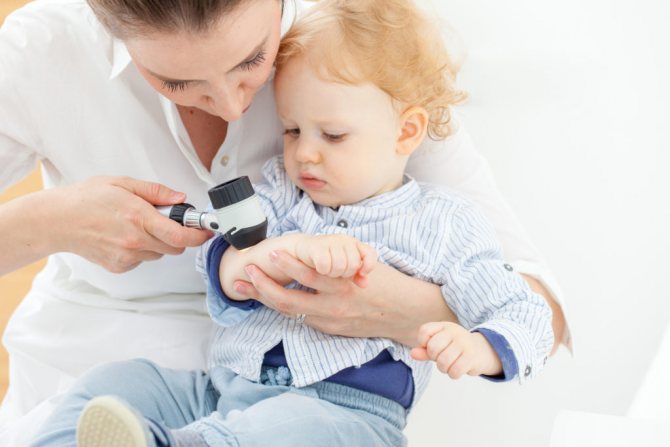
Visit to a dermatologist

